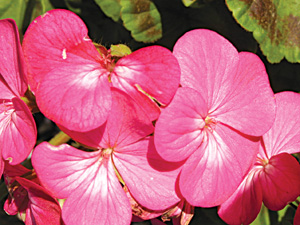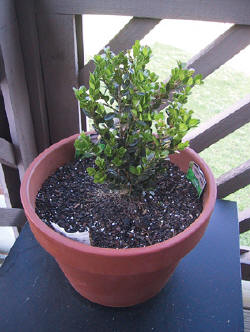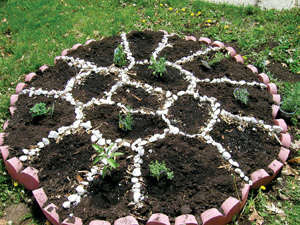|

‘Lak Mal Show 2007’ felicitates flowers
 AWARDS CEREMONY: The exotics and Orchid co-operation society,
better known as ‘Lakmalsala’, held ‘Lak Mal Show 2007’, a grand flower
show at the Vihara Maha Devi Park recently. AWARDS CEREMONY: The exotics and Orchid co-operation society,
better known as ‘Lakmalsala’, held ‘Lak Mal Show 2007’, a grand flower
show at the Vihara Maha Devi Park recently.
Around 80 plant stalls and stalls containing fertilizers, fish, birds
and other accessories were present.
At the end of the show, while celebrating its silver jubilee, an
awards ceremony was held to choose the best plants among the large
number of varieties present.
The highlight of the event was when the titles of the best exhibits
from the main four categories were presented. The awards, categories,
and winning species were as follows:
*Orchid Section
Flori Flora Challenge trophy donated by L.S. Wanitunga for the best
Orchid in bloom at the show - Orchid Cattleya
*Foliage Section
J.M. Piyasena Challenge Trophy for the best foliage plant in the
show-Bromelia
*Anthurium Section
Rohini Silva Challenge Trophy for the best Anthurium plant in
bloom-white Anthurium
*Flowering Plant Section
Best flowering plant in the show (Roses, Hibiscus, Begonia,
Bougainvillaea etc.)-Gerbera Individuals
Picture by Sujani Kumudinee
Flower of the week: Gardener’s favorites: Geraniums
Geraniums (Pelargonium species) are among the most popular flowering
plants. They should be planted outdoors where they will receive at least
6 to 8 hours of sunlight daily.
 They should be planted at the same soil level that they were growing
at in their pot. The soil should be light, loose and well draining; to
which you have added compost, leaf mold or peat moss. They should be planted at the same soil level that they were growing
at in their pot. The soil should be light, loose and well draining; to
which you have added compost, leaf mold or peat moss.
Water geraniums at least once per week if you have had no rain.
Geraniums dislike having wet leaves and flowers so it is best to use a
soaker hose but if that isn’t possible, water early in the day to allow
leaves and flowers to dry before nightfall.
Geraniums like to be well fed, so you should fertilise them. Remove
the flowers promptly as they fade, or the bloom production will decline.
Most bedding plant geraniums are seed grown, and this is an excellent
way to acquire different varieties. For the home gardener who wishes to
keep a certain variety alive, geraniums will root easily from stem
cuttings.
Take cuttings from healthy plants which have been kept rather dry for
a couple of weeks. Use a clean, sharp knife and make a cutting 3 to 4
inches in length from the growing tips.
Trim off the lower leaves from the cutting, and stick it into a
coarse, sandy medium in small pots or in flats, and water well.
Place them in indirect light. Do not allow the cuttings to dry out.
After roots are formed, move the new plants into full sun and water only
enough to keep them from shriveling. Fertilize with a weak solution of
liquid fertiliser every two weeks.
An inside look into creating a perfect herb garden
Unlike many other types of gardening, herbs are very inexpensive and
easy to maintain. The beginner can be an instant success, and as time
goes by, develop into a master gardener, growing more difficult and
esoteric plants.
There is room for all skill levels, and many different garden
situations. In terms of modern usage, herbs can be broken down into
three different groupings.
1. Culinary herbs
2. Medicinal herbs
3. Ornamental herbs
*Culinary herbs
First in most people’s minds are the culinary herbs. These are the
herbs we are all most familiar with basil, rosemary, parsley and
oregano, etc.
 In growing these plants, we not only provide ourselves with the joy
of gardening, but the satisfaction of eating the fruits of our labour. In growing these plants, we not only provide ourselves with the joy
of gardening, but the satisfaction of eating the fruits of our labour.
The flavourings that herb gardens provide to our daily bread can
truly enhance our lives. Ask anyone who has used fresh herbs in their
cooking and they’ll tell you that dried herbs cannot compare.
Some are perennial, some are annual and with few exceptions, all are
easily grown. Everyone can grow these plants, from the window boxes and
container gardens of apartment dwellers, to the borders and raised beds
of country folk. It is one of those simple pleasures that is an
inexpensive luxury.
*Medicinal herbs
The next group of herb plants are medicinals. While this type of herb
had lost most of its value to the 20th century world, one has only to
walk down the aisle of your local drugstore to see its resurgence.
Echinacea, valerian, hypericum, gingko, and garlic are all back on
the shelves as medicine. Lavender, roses, mint, and basil are being used
for aromatherapies to ease the stresses of modern life.
We are once again finding healing from nature. Less than ten percent
of new drugs coming onto the market are entirely man made and nearly
eighty percent are derived from plant material.
For the home gardener however, it is difficult to extract the
medicinal parts of the plant. However do try and grow a few ginger,
coriander and turmeric plants in your garden. You will be very thankful
for this in an emergency.
*Ornament herbs
Ornamental herbs are almost a contradiction in terms. Herbs have
traditionally been plants that have had values other than the aesthetic.
As time has passed, we have found many medicinals to be unhealthy.
The plants however, remain in the lexicon of herb gardeners and in
their gardens. Many of the plants thought of as mainstays of the herb
garden are holdovers from superstition and magic. Perhaps that is part
of the mystique of herb gardening...
*Herb garden design
 The herb garden is historically a more formal design. When we think
of herb gardens, we generally tend to think of the clipped hedges of the
parterre, or the precise brick walkways of the colonial herb garden. The herb garden is historically a more formal design. When we think
of herb gardens, we generally tend to think of the clipped hedges of the
parterre, or the precise brick walkways of the colonial herb garden.
In today’s world, the formal lines and designs can be hard to fit
into our modern panorama, and we should look to make our herb garden fit
our landscape and not the other way around.
*Herb container gardening
My herb garden at home is a container garden. The doorway from our
kitchen opens onto a paved area, so this is the perfect answer for my
situation. All things being equal, I think this is probably the best
style for me.
Even if I lived in my own home, I like the informal jumble of pots by
the kitchen door.
The different glazes and textures of the pots lend colour to what
could have been a very green garden, and containers allow me to adjust
soil mixtures to suit specific plants.
Window-boxes are another form of container with all the benefits
previously mentioned, plus the added attraction of being just outside a
kitchen window. To sum up, containers are easy and fun. It is highly
recommendable for those just starting out.
*Raised bed herb gardens
Closely related to container gardens, raised beds are a great way to
herb gardens. We can amend our soil to suit our plants; this is
important, as many of our favourite herb plants require more drainage
than our soils allow.
The higher the raised bed, the better the drainage. Higher beds are
also wonderful for older or handicapped gardeners, allowing easy access
without bending or stooping.
The raised beds also perform one other function that mirrors the
container gardens; they contain the plants. Plants like mint can become
a terror if let loose in the landscape, and weeds can choke the life out
of the herbs. Raised beds and containers keep the wild ones in, and keep
the bad guys out.
The herb garden need not be the monocultural garden of old. The
informal border fits virtually any type of home, and allows for easy
combination with already existing plants.
Just remember that single herb planted together with other single
plants of other species will just begin to look cluttered.
Planting in threes and fives allows the eye to register the plant,
and yet move restfully over it to the next group. This is a technique
known to every designer, and it’s the number one reason why his or her
gardens look better than others. |

